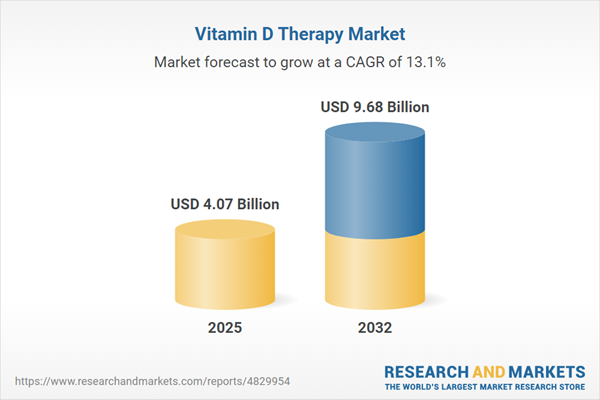Speak directly to the analyst to clarify any post sales queries you may have.
The vitamin D therapy market is transforming as digital health technologies, regulatory innovation, and shifting care models demand actionable market intelligence for strategic decisions. Senior decision-makers must navigate a dynamic environment, leveraging authoritative insights to identify new opportunities and sustainability challenges.
Market Snapshot: Vitamin D Therapy Market Growth Trajectory
In 2024, the global vitamin D therapy market reached USD 3.61 billion and is forecast to grow to USD 4.07 billion by 2025, with further expansion anticipated beyond USD 9.68 billion by 2032. This positions the market for a strong compound annual growth rate (CAGR) of 13.11%. Expansion is underpinned by increased awareness of vitamin D deficiencies, demand for tailored nutrition interventions, and the integration of digital health technologies, which improve disease management and streamline care delivery. Investment from manufacturers, healthcare providers, and technology firms in diagnostics and advanced therapies continues to raise standards and expand patient access worldwide.
Scope & Segmentation of the Vitamin D Therapy Market
- Product Type: Segments include fortified foods and beverages, prescription pharmaceuticals, over-the-counter supplements, and pediatric formulations, all customized to meet varied clinical and preventative needs across age groups and risk profiles.
- Dosage Form: Includes oral softgels, capsules, chewable and standard tablets, liquids, injectables, and topical solutions, providing broad flexibility and supporting patient adherence in diverse care contexts.
- Distribution Channel: Covers hospital pharmacies, retail outlets, and digital platforms, each facilitating faster and wider therapy access, particularly in regions with infrastructure or mobility limitations.
- End User: Ranges from hospitals and clinics to home healthcare and digitally engaged patients, highlighting the industry’s move toward proactive, patient-centric solutions.
- Indication: Spans hypocalcemia, osteoporosis, psoriasis, rickets, and multiple acute and chronic conditions, affirming vitamin D therapy’s value throughout the healthcare continuum and adding depth to both prevention and treatment strategies.
- Region: The Americas, Europe, Middle East & Africa, and Asia-Pacific each offer unique regulatory frameworks and consumer behaviors, shaping local partnerships and market entry approaches for stakeholders.
- Leading Companies: Key organizations—Koninklijke DSM N.V., BASF SE, Lonza Group Ltd., Adisseo France S.A.S., Kemin Industries, Archer Daniels Midland Company, Cargill, Glanbia, Prinova Group, and Barentz International B.V.—drive segment innovation, supply chain control, and regional competitiveness through technological advancement and collaborative strategies.
Key Takeaways for Senior Decision-Makers
- Precision dosing and digital monitoring tools now enhance oversight and tracking throughout vitamin D therapy programs, ensuring compliance and better patient outcomes.
- The growth of remote and digital care models sustains therapy adherence and supports continuity, aligning delivery models with shifting population and public health needs.
- Comprehensive dosage forms enable flexible treatment pathways, making public health initiatives more effective by addressing varied patient groups and geographic requirements.
- Cross-industry partnerships among pharmaceutical, nutrition, and technology players foster responsive supply chains and enhance market resilience in the face of changing regulations and demand patterns.
- Proactive policy and outreach measures are pivotal to expanding patient access, building equity, and increasing provider participation in underserved or evolving markets.
- Continuous, data-driven tracking of clinical outcomes and consumer behavior equips organizations to adjust strategies quickly, preserving competitiveness across regions and care settings.
Tariff Impact on Supply Chain and Pricing
- Recent U.S. tariffs have driven companies to diversify supply networks, which has bolstered operating resilience and maintained reliable market access to vitamin D therapy products.
- Regional manufacturing strategies and logistics planning now focus on minimizing disruptions and supporting stable pricing as tariffs fluctuate.
- Procurement teams are prioritizing adaptive contracts and risk management practices to ensure supply continuity and operational efficiency within shifting market environments.
- Optimized production scheduling and enhanced inventory management are key factors supporting consistent market presence and reinforcing supply chain integrity.
Methodology & Data Sources
This report synthesizes direct interviews with clinicians, business executives, and supply chain experts active in vitamin D therapy, cross-verified using peer-reviewed publications and established industry datasets. This approach ensures high-confidence, decision-ready intelligence for leaders across the sector.
Why This Report Matters: Strategic Vitamin D Therapy Market Insights
- Enables senior leaders to understand how digital transformation, policy changes, and technical innovation are reshaping the vitamin D therapy market.
- Provides clear analysis of market segmentation, assisting competitive planning and informed allocation of resources.
- Equips organizations with the knowledge to optimize supply chains, accelerate market expansion, and mitigate risk amid sector volatility.
Conclusion
Vitamin D therapy is evolving, shaped by technological adoption, regulatory change, and expanded clinical usage. Strategic decision making and collaboration across sectors will define future success and market stability.
Additional Product Information:
- Purchase of this report includes 1 year online access with quarterly updates.
- This report can be updated on request. Please contact our Customer Experience team using the Ask a Question widget on our website.
Table of Contents
3. Executive Summary
4. Market Overview
7. Cumulative Impact of Artificial Intelligence 2025
Companies Mentioned
The companies profiled in this Vitamin D Therapy market report include:- Koninklijke DSM N.V.
- BASF SE
- Lonza Group Ltd.
- Adisseo France S.A.S.
- Kemin Industries, Inc.
- Archer Daniels Midland Company
- Cargill, Incorporated
- Glanbia plc
- Prinova Group LLC
- Barentz International B.V.
Table Information
| Report Attribute | Details |
|---|---|
| No. of Pages | 191 |
| Published | October 2025 |
| Forecast Period | 2025 - 2032 |
| Estimated Market Value ( USD | $ 4.07 Billion |
| Forecasted Market Value ( USD | $ 9.68 Billion |
| Compound Annual Growth Rate | 13.1% |
| Regions Covered | Global |
| No. of Companies Mentioned | 11 |









